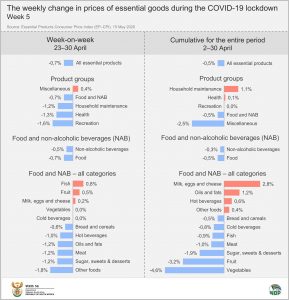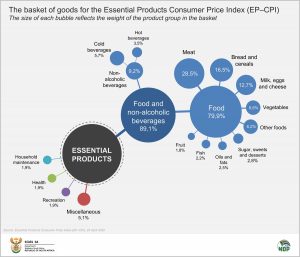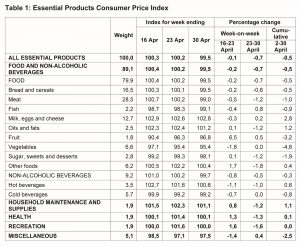COVID-19: Deflation of essential product prices during Level 5 lockdown
The prices of essential products decreased by 0,5% during the COVID‑19 Level 5 lockdown in April. The index increased in the first week of April but then dropped in each of the three successive weeks. The change in the week 23‒30 April was -0,7%.
This is the final report of the weekly essential products price index, as a far wider range of goods was available to consumers in May. This report covers the fifth week of the lockdown (the week ending 30 April 2020). Results for the second, third and fourth weeks of lockdown are covered in two earlier articles, available here and here.
The computation methods for the EP‒CPI and the official CPI are not precisely the same and these results should not be seen as a forecast of the April CPI results.
Food prices decreased by 0,5% over the month and by 0,7% from the previous week. All food categories ended the month in deflationary territory except for milk, eggs and cheese; oils and fats; and ‘other’ foods.
Bread and cereal prices decreased by 0,6% in the last week of the month to show a -0,5% change over the four weeks. Products showing the largest four week change were rice (-4%) and cake flour (6,8%). South Africa’s main staple, mielie meal, ended the month with prices 0,1% lower than the end of March.
Prices for meat products decreased by 1% over April. There was substantial variation between different meat products, with beef generally increasing and chicken and pork generally decreasing. For example, beef mince prices increased by 7,2% and prices for frozen chicken (non-IQF) portions decreased by 5,3%.
A -1,5% change in the prices of frozen hake was the main driver in the -0,9% result for the fish index over the four weeks.
Milk, eggs and cheese products showed price increases of 0,2% in the last week and 2,8% over the month. The monthly increase was mainly due to a large increase in the price of eggs (19,8%) (almost all in the first week) and of cheese spread (6,8%). Cheddar cheese prices increased by 3,9% in the last week but decreased by 0,8% over the month.
Oils and fats increased by 1,2% over April. Margarine spread decreased by 4,9% but cooking oil increased by 5,4%.
Fruit and vegetable prices ended the month lower by 3,2% and 4,6% respectively. Prices for sugar, sweets and desserts declined by 1,2% in the most recent week and by 1,9% over April. White and brown sugar prices declined by 1% and 5% respectively over the four weeks.
Decreases in the prices for baby milk formula (‑5,1%) and baby cereal (‑6%) resulted in a weekly drop in the index for ‘other’ foods of 1,8%. This index ended April 0,4% higher than the last week of March.
Non-alcoholic beverage prices decreased by 0,5% in the week ending 30 April and by 0,3% over the whole month. Canned fizzy drinks increased by 5% and black tea by 4,6% during the month; prices of bottled fizzy drinks and rooibos tea decreased by 2,7% and 1,6% respectively.
There was an average price increase of 1,1% in household maintenance product groups (mainly detergents) during April. Dishwashing liquid (5,4%) and toilet cleaner (4,1%) prices showed significant upward movement.
Over-the-counter health products were little changed over April, increasing by 0,1%, while recreation products were unchanged.
Personal toiletry prices declined by 2,5% on average over the month. Shampoo (‑4,8%), bath soap (‑7,8%) and toothpaste (‑5,3%) all showed monthly price decreases.
How is the EP–CPI calculated?
The index is based on a much smaller basket of goods and services, comprising just under 20% of the weight and 187 of the 412 products in the CPI basket. Food and NAB products dominate, comprising 89,1% of the EP–CPI basket.
The index is calculated using the weighted sum of the geometric average price changes. This is the standard index calculation formula used in the CPI.
As pricing typically does not vary according to area of residence when using online shopping portals, it is not possible to calculate regional EP-CPIs.
This is a temporary project, running only during the April restrictions (Level 5) on consumer products. The official CPI will continue to be published every month. The latest monthly CPI release, for March 2020, is available here.
For technical enquires contact:
Patrick Kelly
Chief Director: Price Statistics
082 888 2248
Similar articles are available on the Stats SA website and can be accessed here.
For a monthly overview of economic indicators and infographics, catch the latest edition of the Stats Biz newsletter here.




